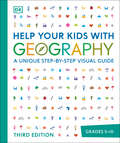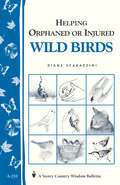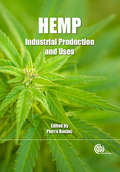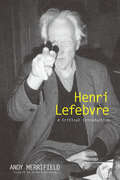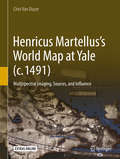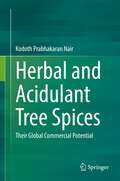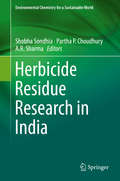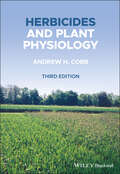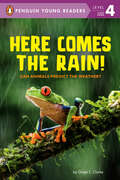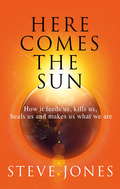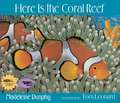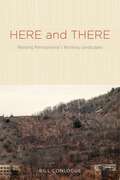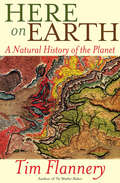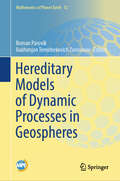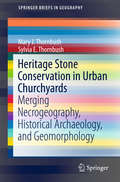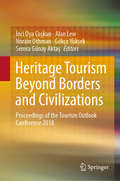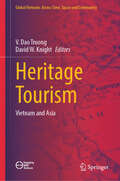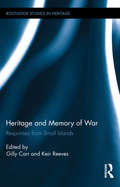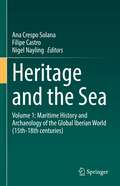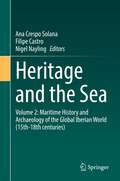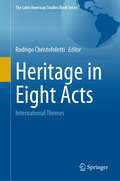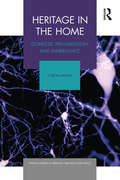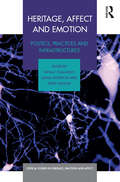- Table View
- List View
Help Your Kids with Geography: A Unique Step-by-Step Visual Guide (DK Help Your Kids)
by DKHelp your kids to be the best in their geography class. This book will help you to understand what they&’re being taught so you can answer all their geography questions. This book is what every frustrated parent needs. Its innovative approach combines colorful diagrams and illustrations with step-by-step explanations, making geography easier to understand than ever before. Covering all the core subjects for 10–16 year olds, from oceans and volcanoes to climate change and population growth, this invaluable guide allows parents and kids to work together to understand even the trickiest topics. You will both soon be experts in map reading, plate tectonics, data handling, and much more.Explore the pages of this great geography book for kids to find:- Concepts of human and physical geography, including fieldwork skills, are made simple, with clear text and step-by-step explanations.- Covers not just aspects of physical geography and human geography, but presents practical skills necessary for succeeding in the subject.- Stimulates children&’s interest in geography, maps, geological features, and human interaction- All content reviewed by educational consultants.- Provides key support for developing geography skills at home alongside school studiesFully revised and updated for 2023, Help Your Kids with Geography is guaranteed to build confidence, reduce stress, and make even the most difficult aspects of this subject simple, clear, and accessible.
Helping Orphaned or Injured Wild Birds: Storey's Country Wisdom Bulletin A-210 (Storey Country Wisdom Bulletin Ser.)
by Diane ScarazziniTo Help or Not to Help? When faced with an injured bird or orphaned nestling, most people want to help but don’t know how – and also fear doing more harm than good. In fact, many wild birds that appear to be in trouble don’t need assistance at all. How do you know whether a bird needs help? How do you know what sort of help the bird needs? In Helping Orphaned or Injured Wild Birds, you’ll find all the information you need on when and how to assist all kinds of birds, from wrens to raptors. You’ll learn how to: Identify whether a bird needs rescuingHelp a baby bird that’s fallen from its nestIdentify the age and species of an injured of orphaned birdPrepare emergency rations for a baby birdAdminister basic bird first-aid Locate a professional wildlife rehabilitator
Hemp
by Laurent Arnaud Pierre Bouloc Serge AllegretHemp production for industrial purposes continues to grow worldwide, and is currently being used for many applications including house insulation, paper making, animal bedding, fabric, rope making and also as a biofuel. This book brings together international experts to examine all aspects of industrial hemp production, including the origins of hemp production, as well as the botany and anatomy, genetics and breeding, quality assessment, regulations, and the agricultural and industrial economics of hemp production. A translation of Le Chanvre Industriel, this book has been revised and updated for an international audience and is essential reading for Producers of industrial hemp, industry personnel and agriculture researchers and students.
Hemp: Industrial Production and Uses
by Pierre BoulocHemp production for industrial purposes continues to grow worldwide, and is currently being used for many applications including house insulation, paper making, animal bedding, fabric, rope making and also as a biofuel. This book brings together international experts to examine all aspects of industrial hemp production, including the origins of hemp production, as well as the botany and anatomy, genetics and breeding, quality assessment, regulations, and the agricultural and industrial economics of hemp production. A translation of Le Chanvre Industriel, this book has been revised and updated for an international audience and is essential reading for Producers of industrial hemp, industry personnel and agriculture researchers and students.
Henri Lefebvre: A Critical Introduction
by Andrew MerrifieldPhilosopher, sociologist and urban theorist, Henri Lefebvre is one of the great social theorists of the twentieth century. This accessible and innovative introduction to the work of Lefebvre combines biography and theory in a critical assessment of the dynamics of Lefebvre's character, thought, and times. Exploring key Lefebvrian concepts, Andy Merrifield demonstrates the evolution of Lefebvre's philosophy, while stressing the way his long and adventurous life of ideas and political engagement live on as an enduring and inspiring interrelated whole.
Henricus Martellus’s World Map at Yale: Multispectral Imaging, Sources, and Influence (c. #1491)
by Chet Van DuzerThis book presents groundbreaking new research on a fifteenth-century world map by Henricus Martellus, c. 1491, now at Yale. The importance of the map had long been suspected, but it was essentially unstudiable because the texts on it had faded to illegibility. Multispectral imaging of the map, performed with NEH support in 2014, rendered its texts legible for the first time, leading to renewed study of the map by the author. This volume provides transcriptions, translations, and commentary on the Latin texts on the map, particularly their sources, as well as the place names in several regions. This leads to a demonstration of a very close relationship between the Martellus map and Martin Waldseemüller’s famous map of 1507. One of the most exciting discoveries on the map is in the hinterlands of southern Africa. The information there comes from African sources; the map is thus a unique and supremely important document regarding African cartography in the fifteenth century. This book is essential reading for digital humanitarians and historians of cartography.
Herbal and Acidulant Tree Spices: Their Global Commercial Potential
by Kodoth Prabhakaran NairThis book discusses leafy spices or herbs known as “aromatic herbs”, which, apart from being used in culinary art for flavoring of foods and beverages, are also known to possess antiseptic, anti-oxidant and other medicinal properties, in addition to many nutraceutical and cosmetic properties. Of the numerous herbs twelve of the commercially important herbs are imported into 4 major European markets, namely, France, Germany, United Kingdom and The Netherlands to the tune of 12000 to 13000 tonnes per annum. This book discusses these leafy herbs and their tremendous commercial potential in international trade. The book offers a comprehensive insight into commercial herbs, with an objective of enhancing their yield, and provides a platform for further research into the global trade potential.
Herbicide Residue Research in India (Environmental Chemistry for a Sustainable World #12)
by Shobha Sondhia Partha P. Choudhury A. R. SharmaHerbicides constitute about 60% of the total pesticides consumed globally. In India, the use of herbicides started initially in tea gardens and picked up in the 1970s, when the high-yielding varieties of rice and wheat were introduced. Presently, 67 herbicides are registered in the country for controlling weeds in crops including cereals, pulses, oilseeds, fibre and tuber crops, and also in the non-crop situations. These chemicals are becoming increasingly popular because of their efficiency and relatively low cost compared with manual or mechanical weeding operations. The contribution of herbicide to total pesticide use, which was only 10-15% during the first decade of the 21st century, has now increased to about 25% with an annual growth rate of 15-20%, which is much higher than insecticides and fungicides. Though the application of herbicides is minimizing yield loss to a great extent, their residues in the food chain and surface and groundwater create some environmental nuisance particularly to non-target organisms. Research on pesticide residues in India was started during 1970s, when such chemicals were introduced on a greater scale along with high-yielding variety seeds, irrigation and chemical fertilizers for increasing food production. However, the herbicide residue research was not given much emphasis until 1990s. The Indian Council of Agricultural Research initiated a national level programme known as All India Coordinated Research Project on Weed Management through the NRC-Weed Science as the main centre along with some centers of ICAR Institutes and state agricultural universities. Over the last two decades, adequate information was generated on estimation, degradation and mitigation of herbicide residues, which were documented in annual reports, bulletins, monographs and scientific articles. However, there was no consolidated compilation of all the available information providing a critical analysis of herbicide residues. Accordingly, an effort has been made in the publication to compile the available information on herbicide residues in India. This is the first report of its kind which presents the findings of herbicide residues and their interactions in the biotic and abiotic environment. There are 16 chapters contributed by the leading herbicide residue scientists, each describing the present status of herbicide use, crops and cropping systems, monitoring, degradation and mitigation, followed by conclusions and future lines of work.This book will be useful to the weed scientists in general and herbicide residue chemists in particular, besides the policy makers, students and all those concerned with the agricultural production in the country.
Herbicides and Plant Physiology
by Andrew H. CobbHERBICIDES AND PLANT PHYSIOLOGY Discover the latest developments in herbicide and weed biology In the newly revised Third Edition of Herbicides and Plant Physiology, distinguished researcher Professor Dr. Andrew H. Cobb delivers an insightful and comprehensive examination of the interaction between herbicides and plant physiology. The book discusses many of the advances in plant physiology, utilizing data from the Arabidopsis genome, and gene editing techniques that have occurred in the last dozen years. This latest edition includes a variety of new and recent references addressing the latest developments in plant research. In addition to a complete introduction to weed biology, the book discusses the modern plant protection industry and the processes by which herbicides are discovered and developed. Readers will find discussions of new targets for the future development of new herbicides, as well as the mechanisms by which modern herbicides interact with plants and achieve their weed control objectives. The book also offers: Thorough introductions to weed biology, the modern plant protection products industry, and how herbicides are discovered and developed Comprehensive explorations of how herbicides gain entry into the plant and move to their sites of action, as well as the basis of herbicide selectivity Practical discussions of how herbicides interact with the major physiological processes in plants and accomplish weed control, including the inhibition of photosynthesis, pigment biosynthesis, and more Reviews recent developments following the use of genetically modified-herbicide resistant crops Perfect for plant biologists and agricultural scientists, this latest edition of Herbicides and Plant Physiology is an indispensable resource for anyone seeking a comprehensive and robust treatment of the latest advances in plant physiology and herbicide action.
Here Comes the Rain!: Can Animals Predict the Weather? (Penguin Young Readers, Level 4)
by Ginjer L. ClarkeLearn about whether or not animals around the world can sense the weather (spoiler alert - some can!) in this photographic nonfiction leveled reader perfect for kids interested in real-life animals that can do unbelievable things!Did you know that sharks have such sensitive hearing that they can tell when hurricanes are coming? Or that you can tell when it's about to rain when sheep start huddling together after they sense a storm on the wind? These animals are real-life weather predictors! With simple language and vivid photographs, Here Comes the Rain!: Can Animals Predict the Weather? is perfect for emerging readers curious about the natural world and the fascinating abilities of the animals that live within it.
Here Comes the Sun: How it feeds us, kills us, heals us and makes us what we are
by Professor Steve Jones'Illuminating!' Professor Brian Cox'Every Steve Jones book is a masterclass in clear and captivating writing with tantalising detours into beguiling anecdotes. Here Comes the Sun is dense with ideas and stories and, like all his books, it will change the way you see the world around you' Robin Ince Our sun drives the weather, forms the landscape, feeds and fuels - but sometimes destroys - the creatures that live upon it, controls their patterns of activity, makes chemicals in the skin that cheer up those who bask in its rays, and for the ancients was the seat of divine authority.In Here Comes the Sun, Steve Jones shows how life on Earth is ruled by our nearest star. It is filled with unexpected connections; between the need to stay cool and man's ability to stand upright, between the power of memory and the onset of darkness, between the flow of solar energy through the plants and animals and of wealth through society, and between Joseph Goebbel's 1938 scheme to make Edinburgh the summer capital of a defeated Britain and the widening gap in the life expectancy of Scottish men compared to that of other European men brought on by thnat nation's cloudy climate. Its author charts some of his own research in places hot and cold across the globe on the genetic and evolutionary effects of sunlight on snails, fruit-flies and people and shows how what was once no more an eccentric specialism has grown to become a subject of wide scientific, social and political significance. Stunningly evocative, beautifully written and packed full of insight, Here Comes the Sun is Steve Jones's most personal book to date.
Here Is The Coral Reef
by Madeleine Dunphy Tom LeonardSet in Australia's Great Barrier Reef, this lyrical rhyming tale introduces young readers to some of the coral reef's most striking residents. From the sleek shark to the colorful parrotfish to the deceptively beautiful sea anemone, each creature in this abundant undersea world relies on another for its existence. Beginning with coral, the very element that defines this ecosystem, Madeleine Dunphy uses a cumulative approach, combining simple yet forceful verse with repetition to reveal the fragile chain that links each of the plants and animals in this unique environment. Tom Leonard's vibrant paintings capture this miraculous circle of life.
Here and There: Reading Pennsylvania's Working Landscapes
by Bill ConlogueThe global economy threatens the uniqueness of places, people, and experiences. In Here and There, Bill Conlogue tests the assumption that literature and local places matter less and less in a world that economists describe as “flat,” politicians believe has “globalized,” and social scientists imagine as a “global village.” Each chapter begins at home, journeys elsewhere, and returns to the author’s native and chosen region, northeastern Pennsylvania. Through the prisms of literature and history, the book explores tensions and conflicts within the region created by national and global demand for its resources: fertile farmland, forest products, anthracite coal, and college-educated young people. Making connections between local and global environmental issues, Here and There uses the Pennsylvania watersheds of urban Lackawanna and rural Lackawaxen to highlight the importance of understanding and protecting the places we call home.
Here and There: Reading Pennsylvania's Working Landscapes
by Bill ConlogueThe global economy threatens the uniqueness of places, people, and experiences. In Here and There, Bill Conlogue tests the assumption that literature and local places matter less and less in a world that economists describe as “flat,” politicians believe has “globalized,” and social scientists imagine as a “global village.” Each chapter begins at home, journeys elsewhere, and returns to the author’s native and chosen region, northeastern Pennsylvania. Through the prisms of literature and history, the book explores tensions and conflicts within the region created by national and global demand for its resources: fertile farmland, forest products, anthracite coal, and college-educated young people. Making connections between local and global environmental issues, Here and There uses the Pennsylvania watersheds of urban Lackawanna and rural Lackawaxen to highlight the importance of understanding and protecting the places we call home.
Here on Earth: A Natural History of the Planet
by Tim FlanneryFrom the internationally acclaimed scientist, explorer, and conservationist comes an awe-inspiring account of earth&’s evolution. Beginning at the moment of creation with the Big Bang, Here on Earth explores the evolution of Earth from a galactic cloud of dust and gas to a planet with a metallic core and early signs of life within a billion years of being created. In a compelling narrative, Flannery describes the formation of the Earth&’s crust and atmosphere, as well as the transformation of the planet&’s oceans from toxic brews of metals (such as iron, copper, and lead) to life-sustaining bodies covering seventy percent of the planet&’s surface. Life, Flannery shows, first appeared in these oceans in the form of microscopic plants and bacteria, and these metals served as catalysts for the earliest biological processes known to exist. From this starting point, Flannery tells the fascinating story of the evolution of our own species, exploring several early human species—from the diminutive creatures (the famed hobbits) who lived in Africa around two million years ago to Homo erectus—before turning his attention to Homo sapiens. Drawing on Charles Darwin&’s and Alfred Russel Wallace&’s theories of evolution and Lovelock&’s Gaia hypothesis, Here on Earth is a dazzling account of life on our planet. &“You&’ll discover why Tim Flannery&’s books have made him the rock star of modern science.&” —Jared Diamond, Pulitzer Prize–winning author of Guns, Germs, and Steel
Hereditary Models of Dynamic Processes in Geospheres (Mathematics of Planet Earth #12)
by Roman Parovik Rakhimjon Temirbekovich ZunnunovThe book is aimed at developing and analyzing fundamentally new mathematical models of dynamicprocesses in the Earth's geospheres, taking into account heredity, in order to detect (predict) natural and manmadethreats. It is known that many natural, technical and social systems are characterized by the property ofheredity (heredity or memory), when the actual dynamic characteristics of the system are determined by itsentire prehistory. Mathematical formalization of such properties in mathematical models is usually ensuredby the introduction of integral terms (memory functionals) with difference kernels. Therefore, taking intoaccount the effects of heredity in dynamic processes and systems also determines the relevance of the study. The topic is devoted to the study of various dynamic processes in geospheres using mathematicalmodeling. Dynamic processes discussed in the book: geomagnetic dynamo, geoacoustic emission,microseismic vibrations, deformation processes, solar activity, seismic activity, processes of transferand accumulation of radon concentration. The book was the first to examine some dynamic processes that have hereditary effects. Researchmethods are based on the following sections of mathematics: mathematical and functional analysis,equations of mathematical physics, differential equations and their systems, integro-differentialequations, fractional calculus, vector analysis, computational mathematics, numerical methods. Alsomethods of object-oriented programming, parallel programming. It should be noted that the research used the principle of the model-algorithm-program triad.Therefore, one of the chapters of the book is devoted to computational algorithms with thepossibility of parallelization. The reader will become familiar with new models of geodynamic processes with heredity andapproaches to their study. The presented numerical algorithms can be reproduced or applied to othersimilar processes. The book will provide comprehensive information about the processes beingstudied and methods of their research, all necessary references will be provided, including thosedefining the current state of affairs in this issue.
Heritage Stone Conservation in Urban Churchyards: Merging Necrogeography, Historical Archaeology, And Geomorphology (SpringerBriefs in Geography)
by Mary J. Thornbush Sylvia E. ThornbushThis book provides a cross-disciplinary perspective on the degradation and deterioration of the cultural record encompassed by urban headstones located in parish churchyards. Its interdisciplinary approach allows the geomorphological analysis of rock weathering to be combined with the impacts on the cultural record, its interpretation, and management. In particular, by examining the impacts of air pollution on the weathering of these cultural markers, cross-temporal assessments can provide valuable information concerning the condition of the record and its sustainability potential as monuments of cultural heritage.Churchyards located in urban settings have grown in interest for the purposes of heritage conservation research. Specifically, headstones represent part of the historical and archaeological record and are recognised as a component of historical archaeology. They are also now approached from the standpoint of heritage conservation, either as monuments or cultural stone as well as being part of necrogeography through their address of burial and stone decay.In this brief, headstones located in parish churchyards in England and Scotland, as part of the Anglican record for the Church of England and the Presbyterian record for the Church of Scotland, were examined using non-destructive methods based on field observations since preliminary research in 2006 as part of a decadal scale (long-term) study. This multisite investigation captures the record since the 17th century, and mainly comprises limestone (England) and sandstone (Scotland) headstone markers that still remain upright. Most studied headstones appear before the 19th century, when this study’s temporal focus terminates. Seriations performed on the available record have revealed trends in style based on inscriptions, epitaphs, and motifs as well as quantified dimensions, shapes, and more. This study represents an attempt to pictorially record cultural stone and to observe cross-temporal and spatial change at various scales. As such, it offers a valuable resource for practitioners, e.g. conservators and archaeologists, as well as for students and researchers.
Heritage Tourism Beyond Borders and Civilizations: Proceedings of the Tourism Outlook Conference 2018
by Alan Lew Norain Othman İnci Oya Coşkun Gökçe Yüksek Semra Günay AktaşThis book gathers the best papers presented at the 11th Tourism Outlook Conference, held in Eskişehir, Turkey, from 3 to 5 October 2018. Covering various aspects of heritage and its effects on tourism issues, the contributions provide a multidisciplinary perspective on emerging issues and challenges in the area. The book also analyzes both the tangible and intangible properties of natural, cultural, and historical heritage and how these relate to and influence tourism, and evaluates the importance and role of heritage in tourism destinations and products. By providing a platform for cross-disciplinary dialogues that integrate research and insights from diverse geographical, sectoral and institutional perspectives, the book allows readers to gain a better understanding of heritage tourism.
Heritage Tourism: Vietnam and Asia (Global Vietnam: Across Time, Space and Community)
by V. Dao Truong David W. KnightThis book provides an overview of research and best practices associated with heritage tourism, with a particular focus on Vietnam, in conversation with heritage tourism in other Asian contexts. These include Iran in the Middle East, Sri Lanka in South Asia, Japan and China in East Asia, Thailand in Southeast Asia, and Brunei and the Philippines in the South Pacific. By delving into crucial questions and challenges relating to cultural innovation, preservation, and authenticity, it offers key lessons for policy-making and theorisation which not only contribute to understanding and improving heritage tourism in Vietnam, specifically, and in Asia more broadly, but also inform efforts to preserve and regenerate both natural and cultural heritage on a global scale. It is relevant to researchers and student communities working within areas of heritage, sustainability, tourism, geography, and in Asian studies.
Heritage and Memory of War: Responses from Small Islands (Contributions To Global Historical Archaeology #1)
by Gilly Carr Keir ReevesEvery large nation in the world was directly or indirectly affected by the impact of war during the course of the twentieth century, and while the historical narratives of war of these nations are well known, far less is understood about how small islands coped. These islands – often not nations in their own right but small outposts of other kingdoms, countries, and nations – have been relegated to mere footnotes in history and heritage studies as interesting case studies or unimportant curiosities. Yet for many of these small islands, war had an enduring impact on their history, memory, intangible heritage and future cultural practices, leaving a legacy that demanded some form of local response. This is the first comprehensive volume dedicated to what the memories, legacies and heritage of war in small islands can teach those who live outside them, through closely related historical and contemporary case studies covering 20th and 21st century conflict across the globe. The volume investigates a number of important questions: Why and how is war memory so enduring in small islands? Do factors such as population size, island size, isolation or geography have any impact? Do close ties of kinship and group identity enable collective memories to shape identity and its resulting war-related heritage? This book contributes to heritage and memory studies and to conflict and historical archaeology by providing a globally wide-ranging comparative assessment of small islands and their experiences of war. Heritage of War in Small Island Territories is of relevance to students, researchers, heritage and tourism professionals, local governments, and NGOs.
Heritage and the Sea: Volume 1: Maritime History and Archaeology of the Global Iberian World (15th-18th centuries)
by Ana Crespo Solana Filipe Castro Nigel NaylingThis two-volume set highlights the importance of Iberian shipbuilding in the centuries of the so-called first globalization (15th to 18th), in confluence with an unprecedented extension of ocean navigation and seafaring and a greater demand for natural resources (especially timber), mostly oak (Quercus spp.) and Pine (Pinus spp.). The chapters are framed in a multidisciplinary and interdisciplinary line of research that integrates history, Geographic Information Sciences, underwater archaeology, dendrochronology and wood provenance techniques. This line of research was developed during the ForSEAdiscovery project, which had a great impact in the academic and scientific world and brought together experts from Europe and America. The volumes deliver a state-of-the-art review of the latest lines of research related to Iberian maritime history and archaeology and their developing interdisciplinary interaction with dendroarchaeology. This synthesis combines an analysis of historical sources, the systematic study of wreck-remains and material culture related to Iberian seafaring from the 15th to the 18th centuries, and the application of earth sciences, including dendrochronology. The set can be used as a manual or work guide for experts and students, and will also be an interesting read for non-experts interested in the subject. Volume 1 focuses on the history and archaeology of seafaring and shipbuilding in the Iberian early modern world, complemented by case studies on timber trade and supply for shipbuilding, analysis of shipbuilding treatises, and the application of Geographic Information Systems and Databases (GIS) to the study of shipwrecks.
Heritage and the Sea: Volume 2: Maritime History and Archaeology of the Global Iberian World (15th–18th centuries)
by Ana Crespo Solana Filipe Castro Nigel NaylingThis two-volume set highlights the importance of Iberian shipbuilding in the centuries of the so-called first globalization (15th to 18th), in confluence with an unprecedented extension of ocean navigation and seafaring and a greater demand for natural resources (especially timber), mostly oak (Quercus spp.) and Pine (Pinus spp.). The chapters are framed in a multidisciplinary and interdisciplinary line of research that integrates history, Geographic Information Sciences, underwater archaeology, dendrochronology and wood provenance techniques. This line of research was developed during the ForSEAdiscovery project, which had a great impact in the academic and scientific world and brought together experts from Europe and America. The volumes deliver a state-of-the-art review of the latest lines of research related to Iberian maritime history and archaeology and their developing interdisciplinary interaction with dendroarchaeology. This synthesis combines an analysis of historical sources, the systematic study of wreck-remains and material culture related to Iberian seafaring from the 15th to the 18th centuries, and the application of earth sciences, including dendrochronology. The set can be used as a manual or work guide for experts and students, and will also be an interesting read for non-experts interested in the subject. Volume 2 focuses on approaches to the study of shipwrecks including a synthesis of dendro-archaeological results, current interdisciplinary case studies and the specialist study of artillery and anchors.
Heritage in Eight Acts: International Themes (The Latin American Studies Book Series)
by Rodrigo ChristofolettiHeritage in Eight Acts brings together contributions on cultural heritage at an international level with an emphasis on Latin American and Ibero-American studies, addressing points of convergence between the local and the global in an accessible and direct way. It discusses themes that have gained importance on the heritage preservation agenda, signaling how Latin America and Europe have expanded their connections and actions in favor of the multiplicity of heritage. Eight scholars from diverse backgrounds bring critical and nuanced understandings of heritage to the context of international relations. From architecture to history and from archeology to art history, each contribution displays methodological creativity and analytical depth. The result is a synthesis with the impact of showing how points of connection can bring Latin America closer to Europe, but not from a relationship of subalternity, but of shared protagonism.
Heritage in the Home: Domestic Prehabitation and Inheritance (Critical Studies in Heritage, Emotion and Affect)
by Caron LipmanThis book explores how people encounter the pasts of their homes, offering insights into the affective, emotional and embodied geographies of domestic heritage. For many people, the intimacy of dwelling is tempered by levels of awareness that their home has been previously occupied by other people whose traces remain in the objects, décor, spaces, stories, memories and atmospheres they leave behind. This book frames home as a site of historical encounter, knowledge and imagination, exploring how different forms of domestic ‘inheritance’ – material, felt, imagined, known – inform or challenge people’s homemaking practices and feelings of belonging, and how the meanings and experiences of domestic space and dwelling are shaped by residents’ awareness of their home’s history. The domestic home becomes an important site for heritage work, an intimate space of memories and histories – both our own but also not our own – a place of real and imagined encounters with a range of selves and others. This book will be of interest to academics, students and professionals in the fields of heritage studies, cultural geography, contemporary archaeology, public history, museum studies, sociology and anthropology.
Heritage, Affect and Emotion: Politics, practices and infrastructures (Critical Studies in Heritage, Emotion and Affect)
by Emma Waterton Steve Watson Divya P. Tolia-KellyHeritage and its economies are driven by affective politics and consolidated through emotions such as pride, awe, joy and pain. In the humanities and social sciences, there is a widespread acknowledgement of the limits not only of language and subjectivity, but also of visuality and representation. Social scientists, particularly within cultural geography and cultural studies, have recently attempted to define and understand that which is more-than-representational, through the development of theories of affect, assemblage, post-humanism and actor network theory, to name a few. While there have been some recent attempts to draw these lines of thinking more forcefully into the field of heritage studies, this book focuses for the first time on relating heritage with the politics of affect. The volume argues that our engagements with heritage are almost entirely figured through the politics of affective registers such as pain, loss, joy, nostalgia, pleasure, belonging or anger. It brings together a number of contributions that collectively - and with critical acuity - question how researchers working in the field of heritage might begin to discover and describe affective experiences, especially those that are shaped and expressed in moments and spaces that can be, at times, intensely personal, intimately shared and ultimately social. It explores current theoretical advances that enable heritage to be affected, released from conventional understandings of both ’heritage-as-objects’ and ’objects-as-representations’ by opening it up to a range of new meanings, emergent and formed in moments of encounter. Whilst representational understandings of heritage are by no means made redundant through this agenda, they are destabilized and can thus be judged anew in light of these developments. Each chapter offers a novel and provocative contribution, provided by an interdisciplinary team of researchers who are thinking theoretically about affect through landscapes, practices of commemoration, visitor experience, site interpretation and other heritage work.
